from ESPN http://ift.tt/1dPqUAn
Soyuz With Expedition 54 Trio Aboard Returns to Earth

The Soyuz MS-06 spacecraft is seen as it lands with Expedition 54 crew members Joe Acaba and Mark Vande Hei of NASA and cosmonaut Alexander Misurkin near the town of Zhezkazgan, Kazakhstan on Wednesday, Feb. 28, 2018 (February 27 Eastern time). via NASA http://ift.tt/2EYTRl2
NGC 613 in Dust, Stars, and a Supernova
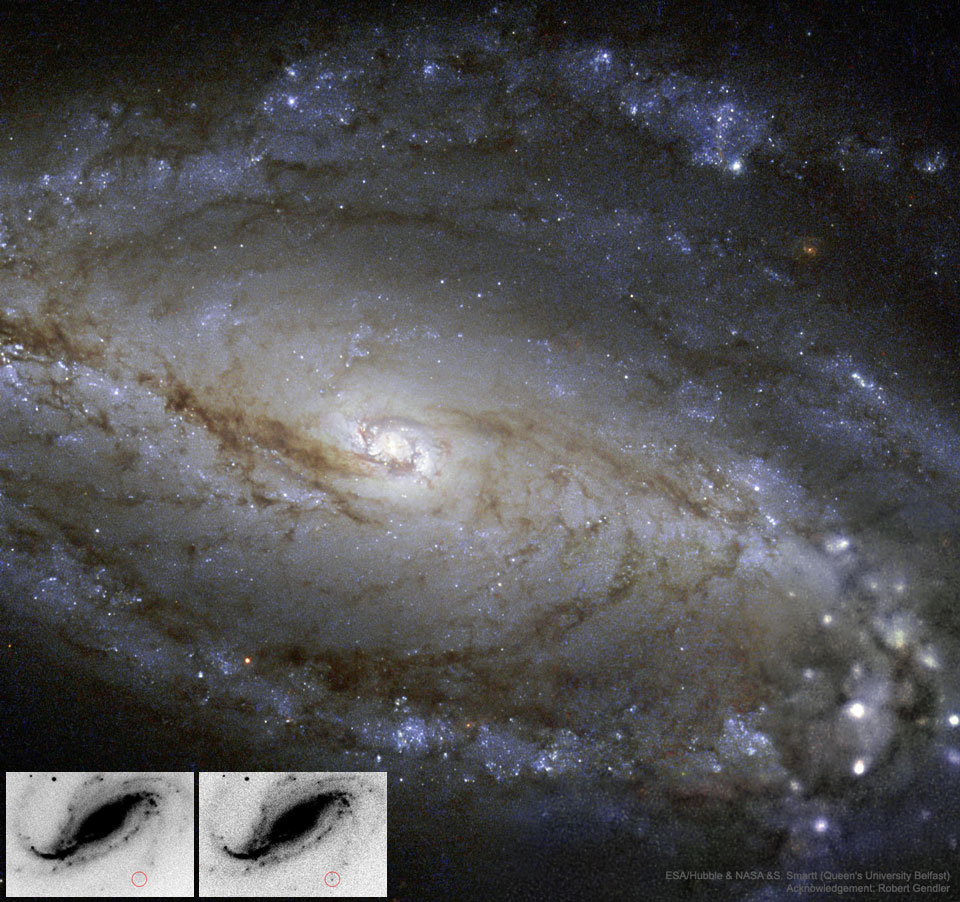
Where did that spot come from? Amateur astronomer Victor Buso was testing out a new camera on his telescope in 2016 when he noticed a curious spot of light appear -- and remain. After reporting this unusual observation, this spot was determined to be light from a supernova just as it was becoming visible -- in an earlier stage than had ever been photographed optically before. The discovery before and after images, taken about an hour apart, are shown in the inset of a more detailed image of the same spiral galaxy, NGC 613, taken by the Hubble Space Telescope. Follow-up observations show that SN 2016gkg was likely the explosion of a supergiant star, and Buso likely captured the stage where the outgoing detonation wave from the stellar core broke through the star's surface. Since astronomers have spent years monitoring galaxies for supernovas without seeing such a "break out" event, the odds of Buso capturing this have been compared to winning a lottery. via NASA http://ift.tt/2FGieBj
Final: Giants 14 Diamondbacks 12. WP: SF C Heston (0-1) LP: ARI A Vasquez (ESPN)
from ESPN http://ift.tt/1dPqUAn
Portrait of the Expedition 54 Crew on the Space Station

The six-member Expedition 54 crew poses for a lighthearted crew portrait inside the Japanese Kibo laboratory module on Feb. 18, 2018. Three of the crew members are packed up and prepared to return to Earth today, Tuesday, Feb. 27. via NASA http://ift.tt/2HPTerZ
Final: Royals 10 Giants 6. WP: KC B Flynn (0-0) LP: SF T Beede (ESPN)
from ESPN http://ift.tt/1dPqUAn
An Intersection of Land, Ice, Sea and Clouds

Though sea ice has been significantly below normal extent and thickness across much of the Arctic, the ice in the Labrador Sea has been relatively close to normal. via NASA http://ift.tt/2HLW018
Passing Jupiter

Here comes Jupiter! NASA's robotic spacecraft Juno is continuing on its 53-day, highly-elongated orbits around our Solar System's largest planet. The featured video is from perijove 11, the eleventh time Juno has passed near Jupiter since it arrived in mid-2016. This time-lapse, color-enhanced movie covers about four hours and morphs between 36 JunoCam images. The video begins with Jupiter rising as Juno approaches from the north. As Juno reaches its closest view -- from about 3,500 kilometers over Jupiter's cloud tops -- the spacecraft captures the great planet in tremendous detail. Juno passes light zones and dark belt of clouds that circle the planet, as well as numerous swirling circular storms, many of which are larger than hurricanes on Earth. After the perijove, Jupiter recedes into the distance, now displaying the unusual clouds that appear over Jupiter's south. To get desired science data, Juno swoops so close to Jupiter that its instruments may soon fail due to exposure to high levels of radiation. Because of this, in part, the Juno mission is currently schedule to conclude in mid-2018, at perijove 14, when the spacecraft will be directed to dive into Jupiter's atmosphere and melt. via NASA http://ift.tt/2FvQzTt
Final: Cubs 12 Giants 10. WP: CHC R Rosario (0-0) LP: SF D Rodriguez (ESPN)
from ESPN http://ift.tt/1dPqUAn
AE Aurigae and the Flaming Star Nebula
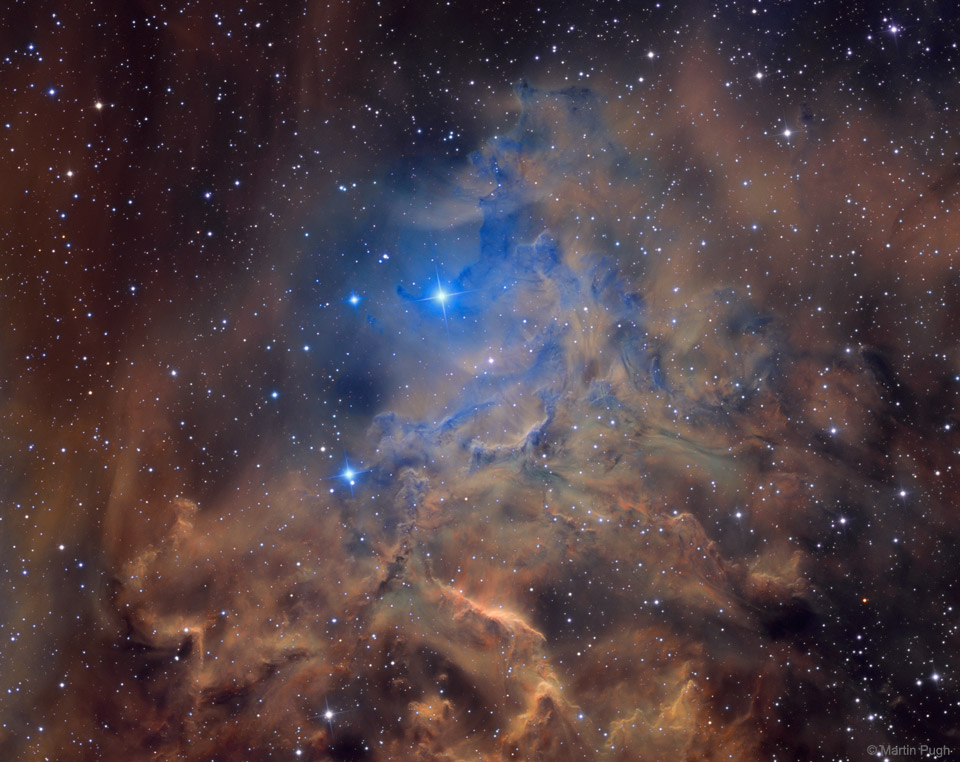
Why is AE Aurigae called the flaming star? For one reason, the surrounding nebula IC 405 is named the Flaming Star Nebula because the region seems to harbor smoke, even though nothing is on fire, including interior star AE Aurigae. Fire, typically defined as the rapid molecular acquisition of oxygen, happens only when sufficient oxygen is present and is not important in such high-energy, low-oxygen environments. The material that appears as smoke is mostly interstellar hydrogen, but does contain smoke-like dark filaments of carbon-rich dust grains. The bright star AE Aurigae is visible near the nebula center and is so hot it is blue, emitting light so energetic it knocks electrons away from atoms in the surrounding gas. When an atom recaptures an electron, light is emitted creating the surrounding emission nebula. The Flaming Star nebula lies about 1,500 light years distant, spans about 5 light years, and is visible with a small telescope toward the constellation of the Charioteer (Auriga). via NASA http://ift.tt/2oAo2UP
Final: Giants 9 Dodgers 3. WP: SF S Okert (1-1) LP: LAD M Banuelos (ESPN)
from ESPN http://ift.tt/1dPqUAn
Time-lapse Sequence of Jupiter’s South Pole

This series of images captures cloud patterns near Jupiter's south pole, looking up towards the planet’s equator. via NASA http://ift.tt/2oj1Yi8
Robert Lawrence: America's First African-American Astronaut

On June 30, 1967, the U.S. Air Force selcted Maj. Robert H. Lawrence, Jr. for the Manned Orbiting Laboratory, Authorized in August 1965, a program which envisioned a series of mini-space stations in low polar Earth orbit. via NASA http://ift.tt/2ELcAfC
When Roses Aren t Red
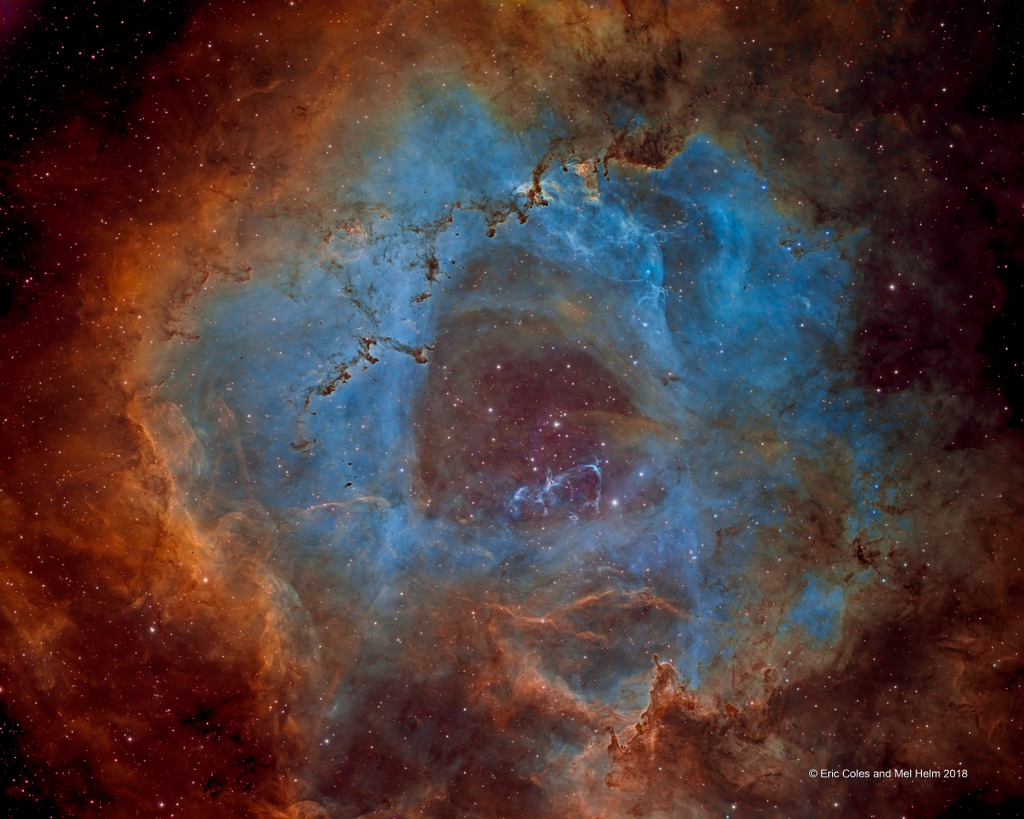
Not all roses are red of course, but they can still be very pretty. Likewise, the beautiful Rosette Nebula and other star forming regions are often shown in astronomical images with a predominately red hue, in part because the dominant emission in the nebula is from hydrogen atoms. Hydrogen's strongest optical emission line, known as H-alpha, is in the red region of the spectrum, but the beauty of an emission nebula need not be appreciated in red light alone. Other atoms in the nebula are also excited by energetic starlight and produce narrow emission lines as well. In this gorgeous view of the Rosette Nebula, narrowband images are combined to show emission from sulfur atoms in red, hydrogen in blue, and oxygen in green. In fact, the scheme of mapping these narrow atomic emission lines into broader colors is adopted in many Hubble images of stellar nurseries. The image spans about 100 light-years in the constellation Monoceros, at the 3,000 light-year estimated distance of the Rosette Nebula. To make the Rosette red, just follow this link or slide your cursor over the image. via NASA http://ift.tt/2EV0eoC
Orion’s Powerhouse

A technician works on the European Service Module that will propel the Orion spacecraft in space and provide air, water and electricity for future crews. via NASA http://ift.tt/2CBHPId
Jupiter in Infrared from Hubble
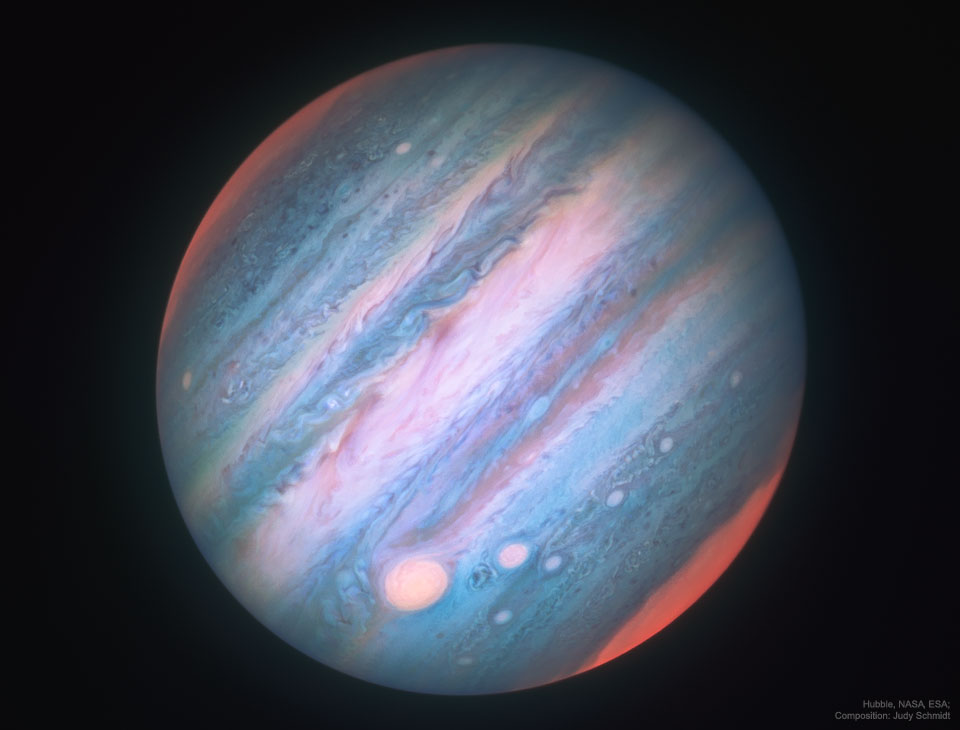
Jupiter looks a bit different in infrared light. To better understand Jupiter's cloud motions and to help NASA's robotic Juno spacecraft understand the Hubble Space Telescope is being directed to regularly image the entire Jovian giant. The colors of Jupiter being monitored go beyond the normal human visual range to include both ultraviolet and infrared light. Featured here in 2016, three bands of near-infrared light have been digitally reassigned into a mapped color image. Jupiter appears different in infrared partly because the amount of sunlight reflected back is distinct, giving differing cloud heights and latitudes discrepant brightnesess. Nevertheless, many familiar features on Jupiter remain, including the light zones and dark belts that circle the planet near the equator, the Great Red Spot on the lower left, and the string-of-pearls storm systems south of the Great Red Spot. The poles glow because high altitute haze there is energized by charged particles from Jupiter's magnetosphere. Juno has now completed 10 of 12 planned science orbits of Jupiter and continues to record data that are helping humanity to understand not only Jupiter's weather but what lies beneath Jupiter's thick clouds. via NASA http://ift.tt/2oku2kg
Destination: History

On Feb. 20, 1962, John Glenn made history by becoming the first U.S. astronaut to orbit the place we call home--planet Earth. via NASA http://ift.tt/2GuM4HY
A Partial Solar Eclipse over Buenos Aires
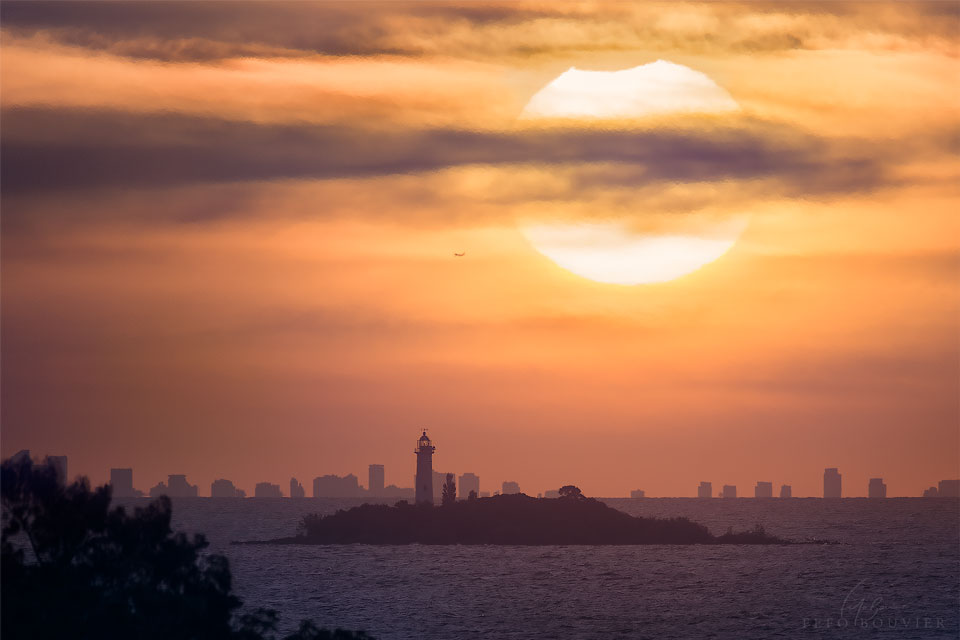
What's happened to top of the Sun? Last week, parts of Earth's southern hemisphere were treated to a partial solar eclipse, where the Moon blocks out part of the Sun. The featured image was taken toward the end of the eclipse from the coast of Uruguay overlooking Argentina's Buenos Aires. Light-house adorned Farallón Island is seen in the foreground, and a plane is visible just to the left of the Sun. The image is actually a digital combination of two consecutive exposures taken with the same camera using the same settings -- one taken of the landscape and another of the background Sun. The next solar eclipse visible on Earth will be another partial eclipse occurring in mid-July and visible from parts of southern Australia including Tasmania. via NASA http://ift.tt/2C73dJH
Galaxy Formation in a Magnetic Universe

How did we get here? We know that we live on a planet orbiting a star orbiting a galaxy, but how did all of this form? To understand details better, astrophysicists upgraded the famous Illustris Simulation into IllustrisTNG -- now the most sophisticated computer model of how galaxies evolved in our universe. Specifically, this featured video tracks magnetic fields from the early universe (redshift 5) until today (redshift 0). Here blue represents relatively weak magnetic fields, while white depicts strong. These B fields are closely matched with galaxies and galaxy clusters. As the simulation begins, a virtual camera circles the virtual IllustrisTNG universe showing a young region -- 30-million light years across -- to be quite filamentary. Gravity causes galaxies to form and merge as the universe expands and evolves. At the end, the simulated IllustrisTNG universe is a good statistical match to our present real universe, although some interesting differences arise -- for example a discrepancy involving the power in radio waves emitted by rapidly moving charged particles. via NASA http://ift.tt/2CuxNZz
LL Ori and the Orion Nebula
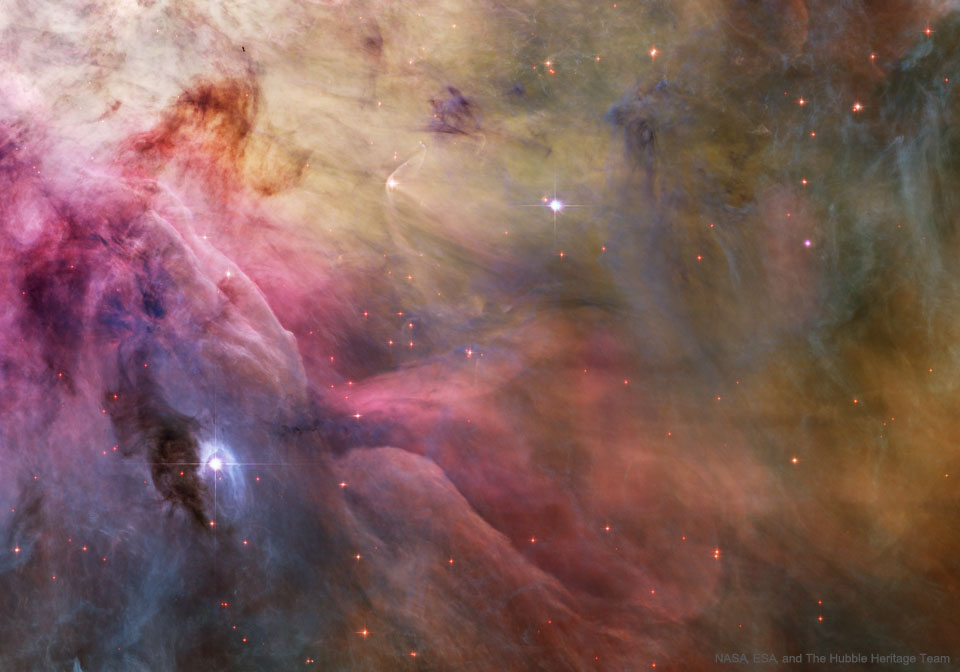
Stars can make waves in the Orion Nebula's sea of gas and dust. This esthetic close-up of cosmic clouds and stellar winds features LL Orionis, interacting with the Orion Nebula flow. Adrift in Orion's stellar nursery and still in its formative years, variable star LL Orionis produces a wind more energetic than the wind from our own middle-aged Sun. As the fast stellar wind runs into slow moving gas a shock front is formed, analogous to the bow wave of a boat moving through water or a plane traveling at supersonic speed. The small, arcing, graceful structure just above and left of center is LL Ori's cosmic bow shock, measuring about half a light-year across. The slower gas is flowing away from the Orion Nebula's hot central star cluster, the Trapezium, located off the upper left corner of the picture. In three dimensions, LL Ori's wrap-around shock front is shaped like a bowl that appears brightest when viewed along the "bottom" edge. This beautiful painting-like photograph is part of a large mosaic view of the complex stellar nursery in Orion, filled with a myriad of fluid shapes associated with star formation. via NASA http://ift.tt/2F9mp8d
Jupiter’s Swirling Cloud Formations

See swirling cloud formations in the northern area of Jupiter's north temperate belt in this new view taken by NASA’s Juno spacecraft. via NASA http://ift.tt/2EvNHVk
Clyde Foster

In June 1975, Marshall management named Clyde Foster to the position of director of the Equal Opportunity Office where he directed and administered a comprehensive program to assure equal opportunity in the conduct of all operations undertaken by the Center and its contractors. via NASA http://ift.tt/2sxlbRE
An Icy Heart

Operation IceBridge, NASA’s longest running survey of the state of polar ice, shattered records in 2017. via NASA http://ift.tt/2CkOvub
Preparing for Space

In this image from 2009, NASA astronaut Stephanie Wilson is attired in a training version of her shuttle launch and entry suit. via NASA http://ift.tt/2EozL3f
The State of NASA

Acting NASA Administrator Robert Lightfoot discusses the fiscal year 2019 budget proposal during a State of NASA address Monday, Feb. 12, 2018. via NASA http://ift.tt/2G73V7z
A Partial Eclipse Over Manila Bay
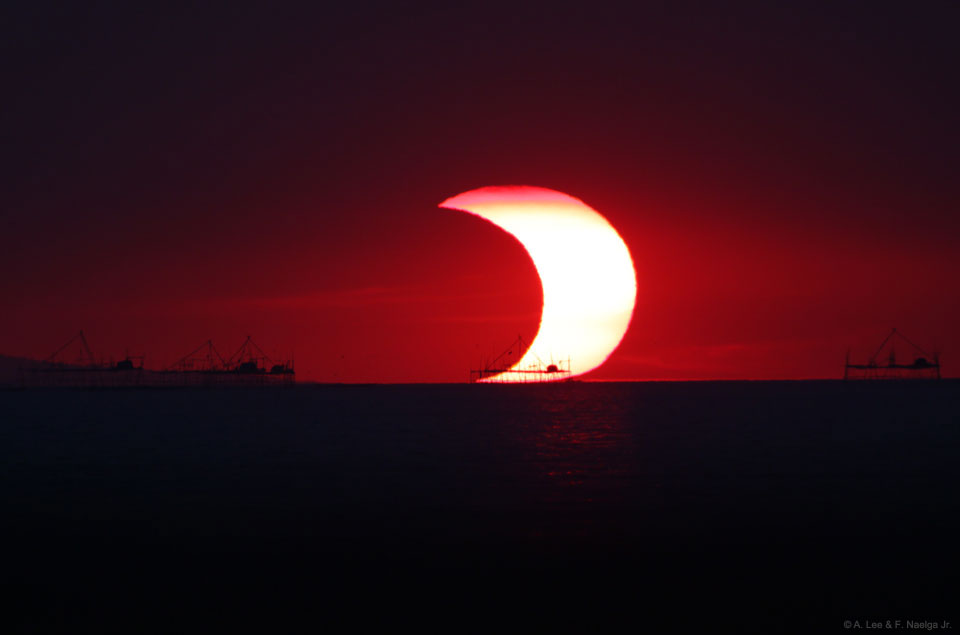
What's happened to the setting Sun? An eclipse! In early 2009, the Moon eclipsed part of the Sun as visible from parts of Africa, Australia, and Asia. In particular the featured image, taken from the Mall of Asia seawall, caught a partially eclipsed Sun setting over Manila Bay in the Philippines. Piers are visible in silhouette in the foreground. Eclipse chasers and well placed sky enthusiasts captured many other interesting and artistic images of the year's only annular solar eclipse, including movies, eclipse shadow arrays, and rings of fire. On Thursday parts of the Sun again will become briefly blocked by the Moon, again visible to some as a partial eclipse of the Sun. Thursday's eclipse, however, will only be visible from parts of southern South America and Antarctica. via NASA http://ift.tt/2Ei6EKV
Roadster, Starman, Planet Earth
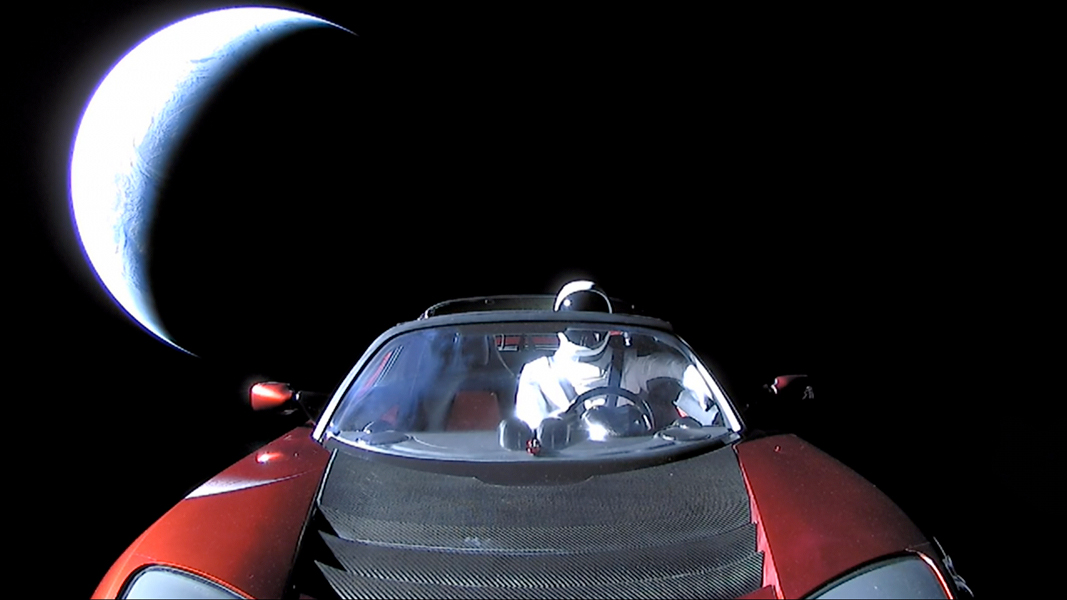
Don't panic. It's just a spacesuited mannequin named Starman. As the sunlit crescent of planet Earth recedes in the background, Starman is comfortably seated at the wheel of a Tesla Roadster in this final image of the payload launched by a Falcon Heavy rocket on February 6. Internationally designated 2018-017A, roadster and Starman are headed for space beyond the orbit of Mars. The successful Falcon Heavy rocket has now become the most powerful rocket in operation and the roadster one of four electric cars launched from planet Earth. The other three were launched to the Moon by historically more powerful (but not reusable) Saturn V rockets. Still, Starman's roadster is probably the only one that would be considered street legal. via NASA http://ift.tt/2C9n06N
A View of the Winter Olympics From Above

Since the Winter Olympics were first held in 1924, they only have been hosted twice in Asia, both times in Japan. This year the games will find a new home in South Korea, in the northeastern cities of Pyeongchang and Gangneung, visible in this natural-color image acquired on Jan. 26, 2018. via NASA http://ift.tt/2EuqiXl
Total Solar Lunar Eclipse
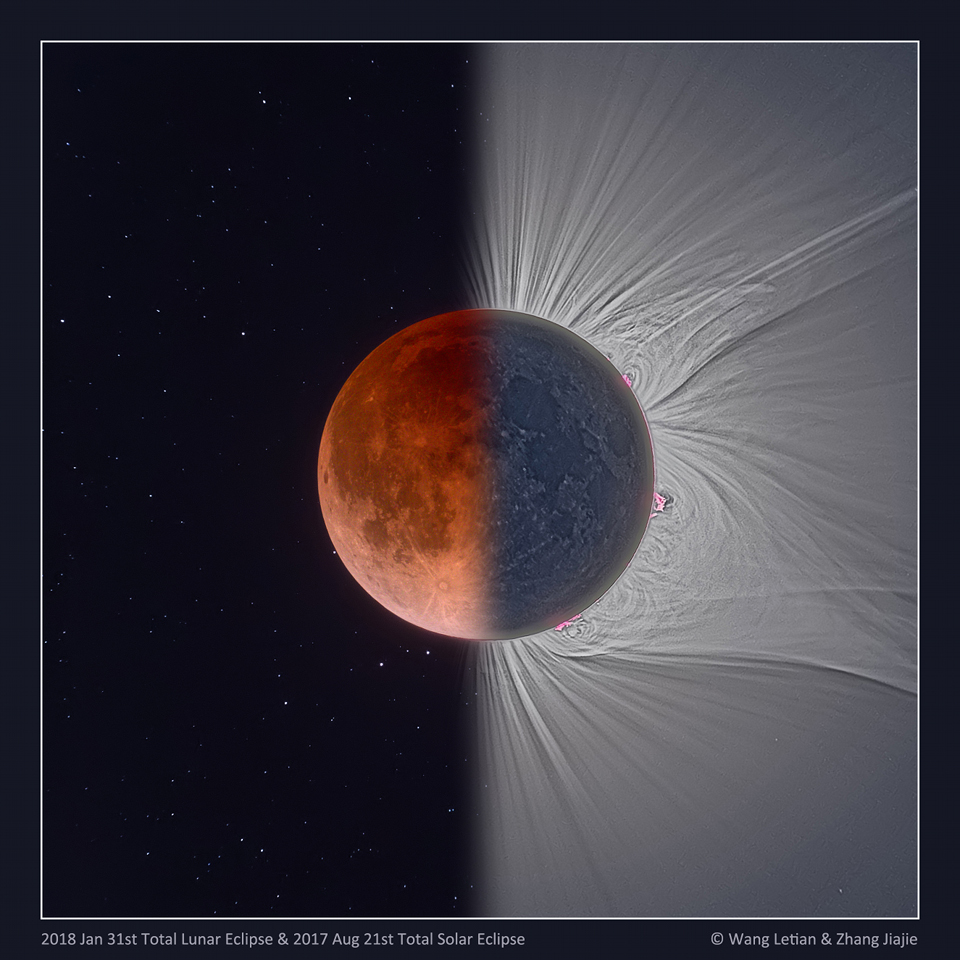
This digitally processed and composited picture creatively compares two famous eclipses in one; the total lunar eclipse (left) of January 31, and the total solar eclipse of August 21, 2017. The Moon appears near mid-totality in both the back-to-back total eclipses. In the lunar eclipse, its surface remains faintly illuminated in Earth's dark reddened shadow. But in the solar eclipse the Moon is in silhouette against the Sun's bright disk, where the otherwise dark lunar surface is just visible due to earthshine. Also seen in the lunar-aligned image pair are faint stars in the night sky surrounding the eclipsed Moon. Stunning details of prominences and coronal streamers surround the eclipsed Sun. The total phase of the Great American Eclipse of August 21 lasted about 2 minutes or less for locations along the Moon's shadow path. From planet Earth's night side, totality for the Super Blue Blood Moon of January 31 lasted well over an hour. via NASA http://ift.tt/2H0ceDv
Splitting Slope Streaks

This image from NASA's Mars Reconnaissance Orbiter (MRO) shows streaks forming on slopes when dust cascades downhill. via NASA http://ift.tt/2EcMFBx
Columbus: Celebrating 10 Years of Science on Station

The European Space Agency's Columbus module celebrates 10 years of science on the International Space Station. via NASA http://ift.tt/2nJ2424
NGC 7331 Close Up
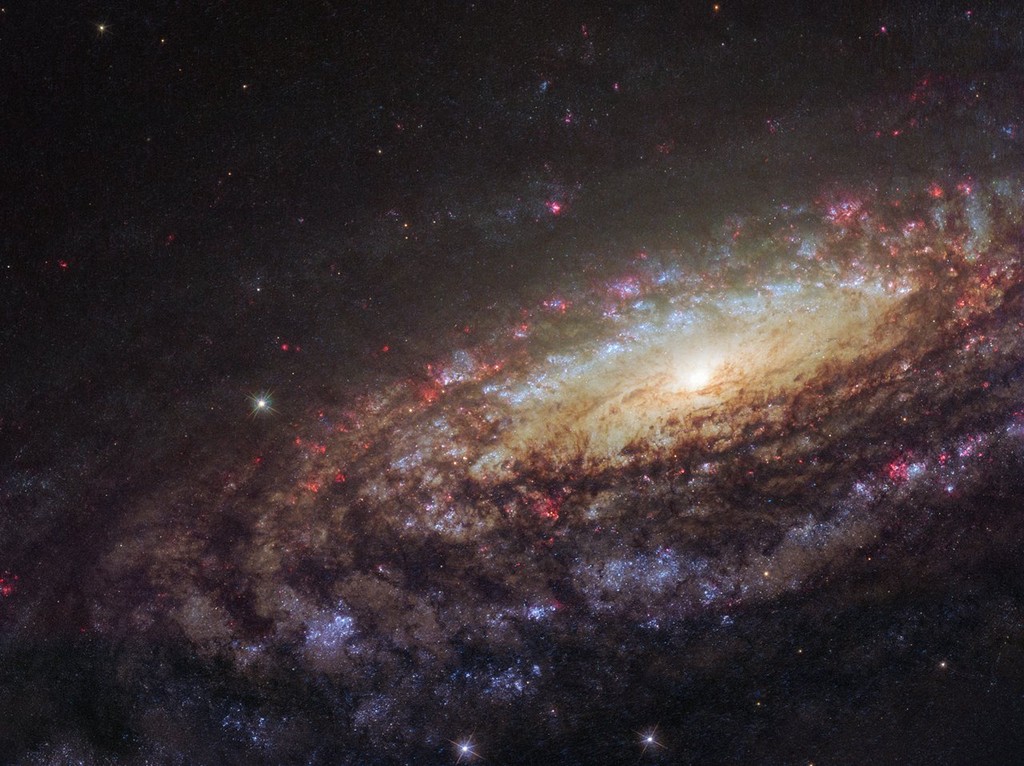
Big, beautiful spiral galaxy NGC 7331 is often touted as an analog to our own Milky Way. About 50 million light-years distant in the northern constellation Pegasus, NGC 7331 was recognized early on as a spiral nebula and is actually one of the brighter galaxies not included in Charles Messier's famous 18th century catalog. Since the galaxy's disk is inclined to our line-of-sight, long telescopic exposures often result in an image that evokes a strong sense of depth. In this Hubble Space Telescope close-up, the galaxy's magnificent spiral arms feature dark obscuring dust lanes, bright bluish clusters of massive young stars, and the telltale reddish glow of active star forming regions. The bright yellowish central regions harbor populations of older, cooler stars. Like the Milky Way, a supermassive black hole lies at the core of of spiral galaxy NGC 7331. via NASA http://ift.tt/2nSqeqm
Giants will retire Barry Bonds' No. 25 on Aug. 11 during series with Pirates (ESPN)
from ESPN http://ift.tt/1dPqUAn
December 2006: Constructing the Space Station

NASA astronaut Robert Curbeam works on the International Space Station's S1 truss during the space shuttle Discovery's STS-116 mission in Dec. 2006. via NASA http://ift.tt/2BHlv4a
Shuttle Discovery Crew's First Spacewalk of STS-116 Mission

NASA astronaut Robert Curbeam works on the International Space Station's S1 truss during the space shuttle Discovery's STS-116 mission in Dec. 2006. via NASA http://ift.tt/2nNSdXU
Galaxy NGC 474: Shells and Star Streams
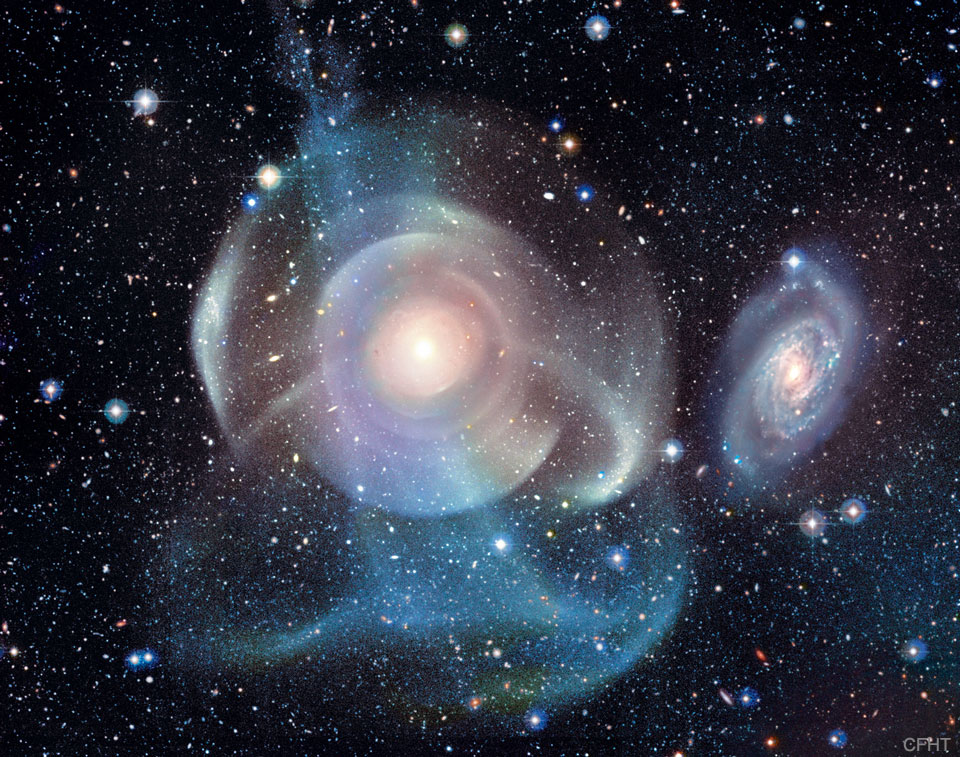
What's happening to galaxy NGC 474? The multiple layers of emission appear strangely complex and unexpected given the relatively featureless appearance of the elliptical galaxy in less deep images. The cause of the shells is currently unknown, but possibly tidal tails related to debris left over from absorbing numerous small galaxies in the past billion years. Alternatively the shells may be like ripples in a pond, where the ongoing collision with the spiral galaxy just above NGC 474 is causing density waves to ripple through the galactic giant. Regardless of the actual cause, the featured image dramatically highlights the increasing consensus that at least some elliptical galaxies have formed in the recent past, and that the outer halos of most large galaxies are not really smooth but have complexities induced by frequent interactions with -- and accretions of -- smaller nearby galaxies. The halo of our own Milky Way Galaxy is one example of such unexpected complexity. NGC 474 spans about 250,000 light years and lies about 100 million light years distant toward the constellation of the Fish (Pisces). via NASA http://ift.tt/2E2NEQx
A Lunar Tribute to Former NASA Chief Exploration Scientist

Lunar crater is named after former NASA chief exploration scientist. via NASA http://ift.tt/2GN1wAh
Venus and the Triply Ultraviolet Sun
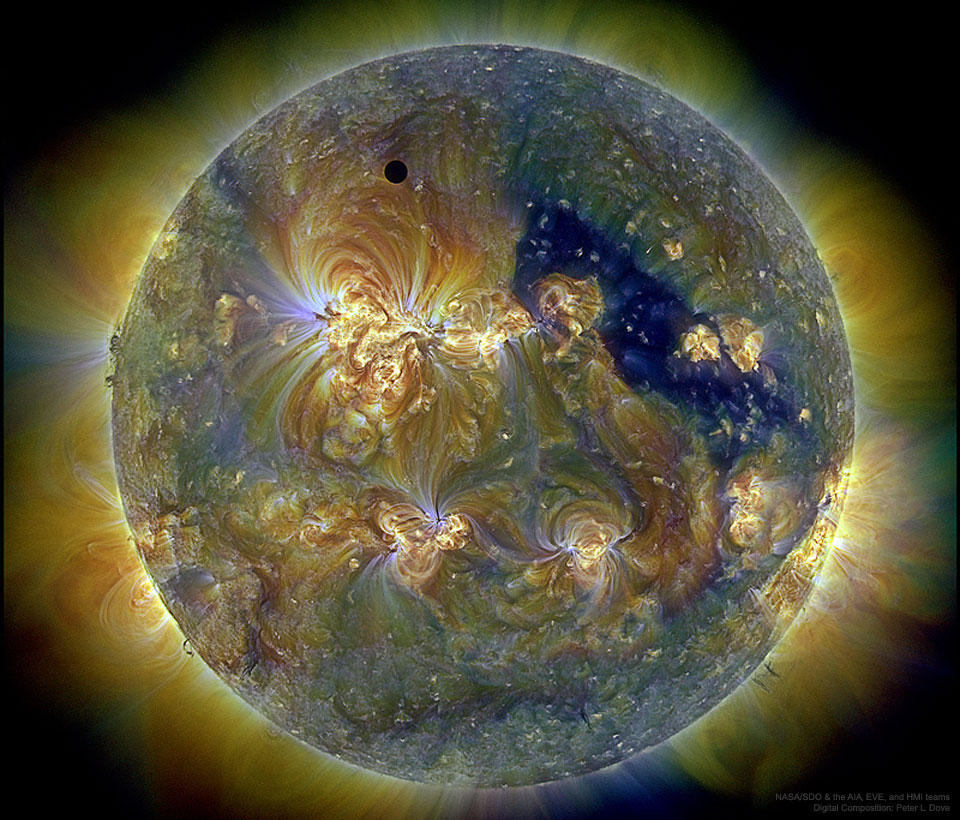
An unusual type of solar eclipse occurred in 2012. Usually it is the Earth's Moon that eclipses the Sun. That year, most unusually, the planet Venus took a turn. Like a solar eclipse by the Moon, the phase of Venus became a continually thinner crescent as Venus became increasingly better aligned with the Sun. Eventually the alignment became perfect and the phase of Venus dropped to zero. The dark spot of Venus crossed our parent star. The situation could technically be labeled a Venusian annular eclipse with an extraordinarily large ring of fire. Pictured here during the occultation, the Sun was imaged in three colors of ultraviolet light by the Earth-orbiting Solar Dynamics Observatory, with the dark region toward the right corresponding to a coronal hole. Hours later, as Venus continued in its orbit, a slight crescent phase appeared again. The next Venusian transit across the Sun will occur in 2117. via NASA http://ift.tt/2s6x54v
Earthshadow and the Beehive
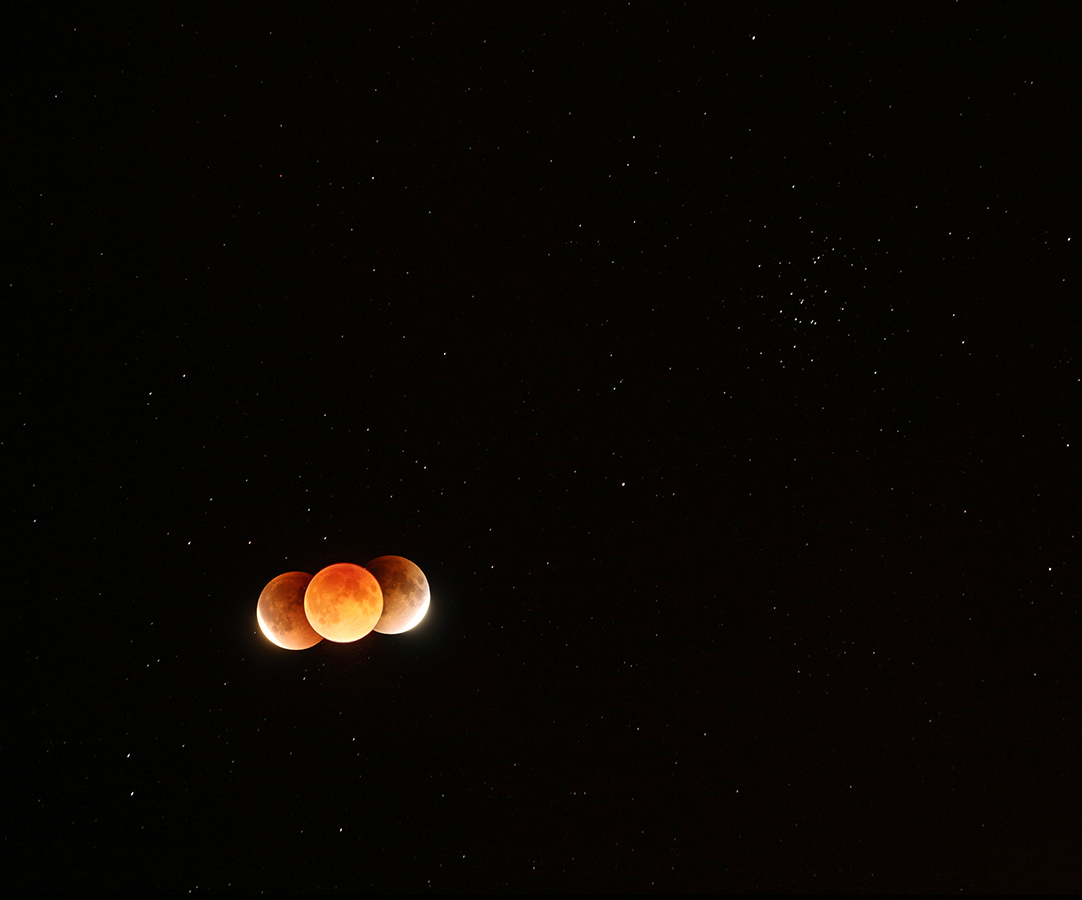
The Earth's dark umbral shadow is shaped like a cone extending into space. Of course its circular cross section at the distance of the Moon is more easily seen during a lunar eclipse. In fact, in this composite telephoto image from Earth's night side on January 31, the Earth's shadow has taken on a reddish tinge. The extent of the shadow along the lunar orbit is illustrated by aligning three frames taken just before the start, near the middle of, and just after the end of the total eclipse phase that lasted about 76 minutes. At the upper right and more easily seen during the eclipse's darker total phase is M44, one of the closest large star clusters. A mere 600 light-years away, M44 is also known as the Praesepe or the Beehive Cluster. via NASA http://ift.tt/2BRYrLl
Observations From -369.7 Degrees Fahrenheit

Taken from inside Chamber A at the Johnson Space Center in September 2017, this image shows the James Webb Space Telescope as it was undergoing cryogenic testing and the temperature was approximately -369.7 degrees Fahrenheit. via NASA http://ift.tt/2BNJqu1
Moonrise Eclipse
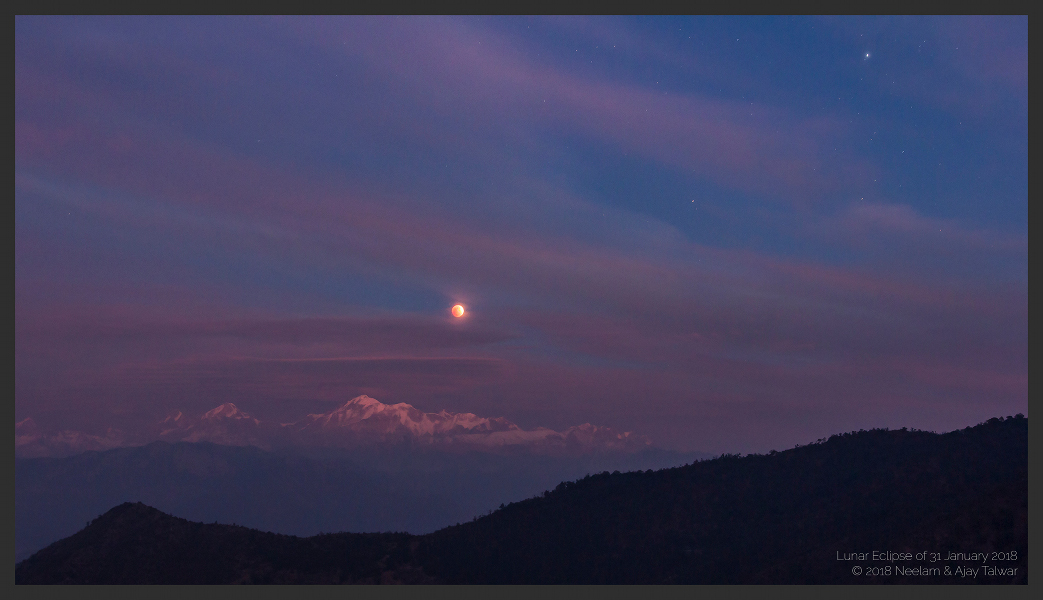
This atmospheric picture of a distant horizon looks toward the tall Trisul peaks of India's snowy Himalayan mountains. Taken from a remote location on January 31, brightest star Sirius shines at the upper right. The red Moon rising is gliding through Earth's shadow during the evening's much anticipated total lunar eclipse. Enjoyed across the planet's night side, the eclipse was the first of two total lunar eclipses in 2018, kicking off a good year for moonwatchers. But this was a rare treat. The eclipsed Moon also loomed large near perigee, the closest point in its orbit, during the second Full Moon of the month, also known as a Blue Moon. For the July 27, 2018 total lunar eclipse, the Full Moon will be very near apogee. via NASA http://ift.tt/2EaQqqp
Helping to Create the Future of Space Travel

Dr. Lonnie Reid had a long and storied career at NASA's Glenn Research Center. His expertise in the internal flow of advance aerospace propulsion system was nationally recognized and he was influential in recruiting and mentoring the next generation of scientists and engineers. via NASA http://ift.tt/2E7noYk
Subscribe to:
Posts (Atom)